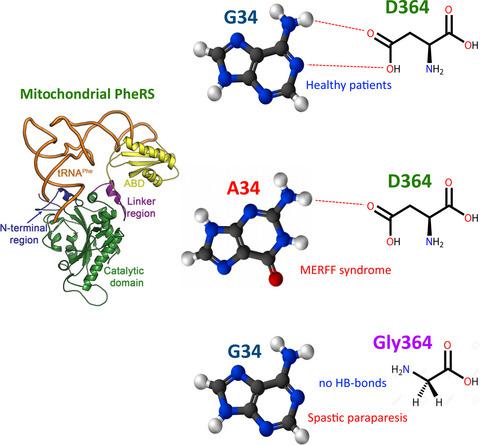Our official English website, www.x-mol.net, welcomes your feedback! (Note: you will need to create a separate account there.)
Breaking a single hydrogen bond in the mitochondrial tRNAPhe -PheRS complex leads to phenotypic pleiotropy of human disease.
The FEBS Journal ( IF 5.4 ) Pub Date : 2020-03-01 , DOI: 10.1111/febs.15268 Moshe Peretz 1 , Dmitry Tworowski 1 , Ekaterine Kartvelishvili 1 , John Livingston 2 , Zofia Chrzanowska-Lightowlers 3 , Mark Safro 1
The FEBS Journal ( IF 5.4 ) Pub Date : 2020-03-01 , DOI: 10.1111/febs.15268 Moshe Peretz 1 , Dmitry Tworowski 1 , Ekaterine Kartvelishvili 1 , John Livingston 2 , Zofia Chrzanowska-Lightowlers 3 , Mark Safro 1
Affiliation

|
Various pathogenic variants in both mitochondrial tRNAPhe and Phenylalanyl‐tRNA synthetase mitochondrial protein coding gene (FARS2) gene encoding for the human mitochondrial PheRS have been identified and associated with neurological and/or muscle‐related pathologies. An important Guanine‐34 (G34)A anticodon mutation associated with myoclonic epilepsy with ragged red fibers (MERRF) syndrome has been reported in hmit‐tRNAPhe. The majority of G34 contacts in available aaRSs‐tRNAs complexes specifically use that base as an important tRNA identity element. The network of intermolecular interactions providing its specific recognition also largely conserved. However, their conservation depends also on the invariance of the residues in the anticodon binding domain (ABD) of human mitochondrial Phenylalanyl‐tRNA synthetase (hmit‐PheRS). A defect in recognition of the anticodon of tRNAPhe may happen not only because of G34A mutation, but also due to mutations in the ABD. Indeed, a pathogenic mutation in FARS2 has been recently reported in a 9‐year‐old female patient harboring a p.Asp364Gly mutation. Asp364 is hydrogen bonded (HB) to G34 in WT hmit‐PheRS. Thus, there are two pathogenic variants disrupting HB between G34 and Asp364: one is associated with G34A mutation, and the other with Asp364Gly mutation. We have measured the rates of tRNAPhe aminoacylation catalyzed by WT hmit‐PheRS and mutant enzymes. These data ranked the residues making a HB with G34 according to their contribution to activity and the signal transduction pathway in the hmit‐PheRS‐tRNAPhe complex. Furthermore, we carried out extensive MD simulations to reveal the interdomain contact topology on the dynamic trajectories of the complex, and gaining insight into the structural and dynamic integrity effects of hmit‐PheRS complexed with tRNAPhe.
中文翻译:

打破线粒体 tRNAPhe -PheRS 复合物中的单个氢键会导致人类疾病的表型多效性。
线粒体 tRNA Phe和苯丙氨酰-tRNA 合成酶线粒体蛋白编码基因 (FARS2) 基因编码人类线粒体 PheRS 的各种致病变异已被鉴定并与神经和/或肌肉相关的病理相关。在hmit ‐tRNA Phe中报道了一个重要的鸟嘌呤‐34 (G34)A 反密码子突变与肌阵挛性癫痫伴不规则红纤维 (MERRF) 综合征相关。. 可用的 aaRSs-tRNAs 复合物中的大多数 G34 接触专门使用该碱基作为重要的 tRNA 身份元素。提供其特异性识别的分子间相互作用网络在很大程度上也是保守的。然而,它们的保守性还取决于人线粒体苯丙氨酰-tRNA 合成酶 ( hmit - PheRS) 的反密码子结合域 (ABD) 中残基的不变性。tRNA Phe的反密码子识别缺陷可能不仅是由于 G34A 突变,还可能是由于 ABD 中的突变。事实上,最近在一名携带 p.Asp364Gly 突变的 9 岁女性患者中报道了 FARS2 的致病性突变。Asp364 在 WT hmit中与 G34 氢键 (HB)-PhRS。因此,在 G34 和 Asp364 之间存在两种破坏 HB 的致病变异:一种与 G34A 突变有关,另一种与 Asp364Gly 突变有关。我们测量了WT hmit -PheRS 和突变酶催化的 tRNA Phe氨酰化率。这些数据根据其对hmit -PheRS-tRNA Phe复合物中的活性和信号转导途径的贡献,对与 G34 形成 HB 的残基进行了排名。此外,我们进行了广泛的 MD 模拟,以揭示复合物动态轨迹上的域间接触拓扑,并深入了解hmit- PheRS 与 tRNA Phe复合的结构和动态完整性效应。
更新日期:2020-03-01
中文翻译:

打破线粒体 tRNAPhe -PheRS 复合物中的单个氢键会导致人类疾病的表型多效性。
线粒体 tRNA Phe和苯丙氨酰-tRNA 合成酶线粒体蛋白编码基因 (FARS2) 基因编码人类线粒体 PheRS 的各种致病变异已被鉴定并与神经和/或肌肉相关的病理相关。在hmit ‐tRNA Phe中报道了一个重要的鸟嘌呤‐34 (G34)A 反密码子突变与肌阵挛性癫痫伴不规则红纤维 (MERRF) 综合征相关。. 可用的 aaRSs-tRNAs 复合物中的大多数 G34 接触专门使用该碱基作为重要的 tRNA 身份元素。提供其特异性识别的分子间相互作用网络在很大程度上也是保守的。然而,它们的保守性还取决于人线粒体苯丙氨酰-tRNA 合成酶 ( hmit - PheRS) 的反密码子结合域 (ABD) 中残基的不变性。tRNA Phe的反密码子识别缺陷可能不仅是由于 G34A 突变,还可能是由于 ABD 中的突变。事实上,最近在一名携带 p.Asp364Gly 突变的 9 岁女性患者中报道了 FARS2 的致病性突变。Asp364 在 WT hmit中与 G34 氢键 (HB)-PhRS。因此,在 G34 和 Asp364 之间存在两种破坏 HB 的致病变异:一种与 G34A 突变有关,另一种与 Asp364Gly 突变有关。我们测量了WT hmit -PheRS 和突变酶催化的 tRNA Phe氨酰化率。这些数据根据其对hmit -PheRS-tRNA Phe复合物中的活性和信号转导途径的贡献,对与 G34 形成 HB 的残基进行了排名。此外,我们进行了广泛的 MD 模拟,以揭示复合物动态轨迹上的域间接触拓扑,并深入了解hmit- PheRS 与 tRNA Phe复合的结构和动态完整性效应。


























 京公网安备 11010802027423号
京公网安备 11010802027423号